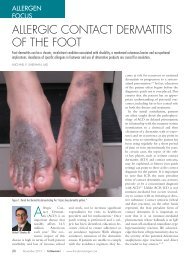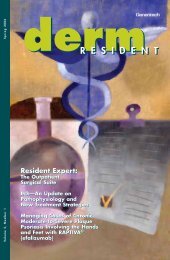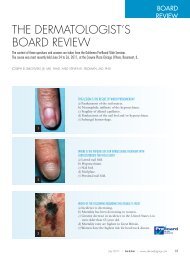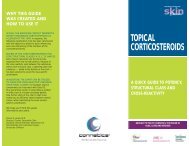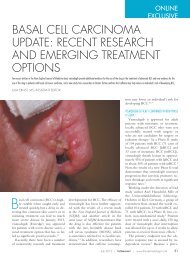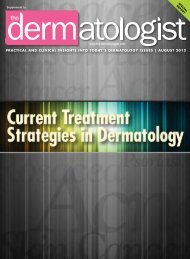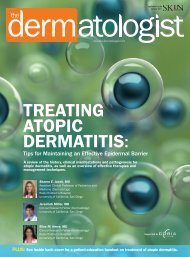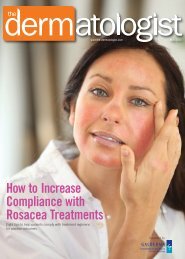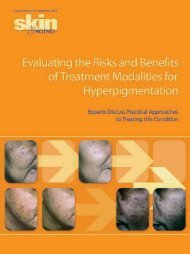Oat Oil Improves the Skin Barrier - The Dermatologist
Oat Oil Improves the Skin Barrier - The Dermatologist
Oat Oil Improves the Skin Barrier - The Dermatologist
You also want an ePaper? Increase the reach of your titles
YUMPU automatically turns print PDFs into web optimized ePapers that Google loves.
<strong>Oat</strong> <strong>Oil</strong> <strong>Improves</strong> <strong>the</strong> <strong>Skin</strong> <strong>Barrier</strong><strong>Oat</strong> oil is rich in linoleic acid, which is an essential polyunsaturated fatty acid critical for <strong>the</strong> maintenance of <strong>the</strong> skin permeability barrier.Michael Southall, PhD, Apostolos Pappas, PhD, Glenn Nystrand, BS, Judith Nebus, MBAJohnson & Johnson Consumer Companies, Inc.<strong>The</strong> outermost layer of <strong>the</strong> epidermis, <strong>the</strong> stratumcorneum, functions as a two-way physical andchemical barrier: it prevents both <strong>the</strong> penetration ofnoxious agents from <strong>the</strong> environment into <strong>the</strong> skin and<strong>the</strong> evaporation of water in <strong>the</strong> opposite direction. <strong>The</strong>stratum corneum is formed by corneocytes and intercellularlipids (lamellae), which contain mostly ceramides(50% of <strong>the</strong> stratum corneum lipid mass), cholesterol(25%) and free fatty acids (10%). 1,2 <strong>The</strong> specific mixtureand organization of <strong>the</strong>se lipids in <strong>the</strong> space betweencorneocytes allows <strong>the</strong> proper maintenance of <strong>the</strong> permeabilitybarrier. <strong>The</strong> significance of ceramides for <strong>the</strong>stratum corneum barrier has been extensively reportedand <strong>the</strong> essential fatty acid (EFA) linoleic acid (LA), containedin ester linkage in acylceramides (ceramide fractions),seems particularly important for <strong>the</strong> normal barrierfunction. 2An alteration in stratum corneum lipids has beenidentified in several skin disorders with damaged permeabilitybarrier, including atopic dermatitis (AD). Acompromised barrier increases <strong>the</strong> penetration of irritants,allergens and pathogens, thus causing or fur<strong>the</strong>ringskin inflammation. 3,4 A defective barrier is not only akey feature of AD, but <strong>the</strong> degree of skin barrier damagecorrelates with <strong>the</strong> disease severity. 5 For this reason,emollients that repair and protect <strong>the</strong> stratum corneumare important for <strong>the</strong> general skin health as well as for <strong>the</strong>improvement of certain eczematous conditions. 4Linoleic Acid and <strong>Skin</strong> <strong>Barrier</strong>LA is one of <strong>the</strong> most significant lipids for <strong>the</strong> maintenanceof barrier function. 6 In fact, recent studies suggestthat LA is essential for <strong>the</strong> formation of <strong>the</strong> lamellarphase of <strong>the</strong> stratum corneum lipids. 2,7 Additionally,studies showed that stratum corneum free fatty acids,including LA, are important for <strong>the</strong> maintenance of <strong>the</strong>surface “acid mantle,” which, in turn, seems importantfor both <strong>the</strong> integrity of <strong>the</strong> permeability barrier andstratum corneum cohesion. 8<strong>The</strong> importance of LA for a healthy skin barrier hasbeen known since <strong>the</strong> 1930s, when pre-clinical experimentsdemonstrated that a prolonged fat-free diet wouldlead to severe scaly dermatosis and a significant increasein transepidermal water loss (TEWL), and that oral intakeof LA would reverse <strong>the</strong>se symptoms. 9 Humanclinical studies have subsequently confirmed <strong>the</strong> reversalTable 1. Lipid Class (%) composition in <strong>the</strong> oat oil oftriple oatLipid Class %Triglycerides 83.4Free Fatty Acids 6.8Diacylglycerols 8.9Phospholipids 0.9Triglycerides are <strong>the</strong> most abundant lipids in oat oil. <strong>The</strong> fatty acids oleic acid (OA) and linoleicacid (LA) are contained in various percentages in each of <strong>the</strong> four lipid classes (35% to 43% forOA and 36% to 45% for LA).of <strong>the</strong> cutaneous manifestation of EFA deficiency afterconsumption of LA-rich diet. 10 Since <strong>the</strong>n, studies haveshown skin barrier improvement also via topical applicationof LA or of oils rich in LA (eg, sunflower seedoil). 11,12 In 1975, Prottey et al demonstrated decreasedscaliness and decreased TEWL (ie, improved barrier)in EFA deficient patients treated for 2 weeks with sunflower-seedoil applied to <strong>the</strong> forearms; interestingly,improvement did not occur in <strong>the</strong> contralateral forearmtreated with olive oil, rich in oleic acid. 11In preclinical studies, topical LA-rich oils were alsoshown to improve <strong>the</strong> skin barrier in EFA deficiencymodels or in skin disrupted by sodium laurate; in bothgroups, skin applications of sunflower seed oil normalized<strong>the</strong> high TEWL. 12 Interestingly, linoleic acid from<strong>the</strong> sunflower seed oil application was detected in <strong>the</strong>epidermal lipids of <strong>the</strong> EFA deficient group. 12 A laterstudy by Elias et al 6 confirmed <strong>the</strong>se results: in an EFAdeficient preclinical model, <strong>the</strong> application of pure LAto <strong>the</strong> skin quickly improved <strong>the</strong> barrier function (decreasedTEWL), while contralateral application of pureoleic acid produced deterioration of <strong>the</strong> skin barrier(increased TEWL). In fact, pure oleic acid, in its unbound,free fatty acid form, has been shown to actuallyincrease <strong>the</strong> skin permeability by disrupting <strong>the</strong> lamellarlipid arrangement in <strong>the</strong> stratum corneum and thusfunctioning as a penetration enhancer. 13,14 It is importantto note, though, that <strong>the</strong> vast majority of oleic componentsin vegetable oils are present in esterified and boundforms. Topical formulations, containing vegetable oils,are designed with additional stabilization to maintain <strong>the</strong>structure of <strong>the</strong> emulsion, to normalize <strong>the</strong> pH rangeand to prevent microbial growth. All of <strong>the</strong>se factors are2 September 2012 • Supplement to <strong>The</strong> <strong>Dermatologist</strong> ®



